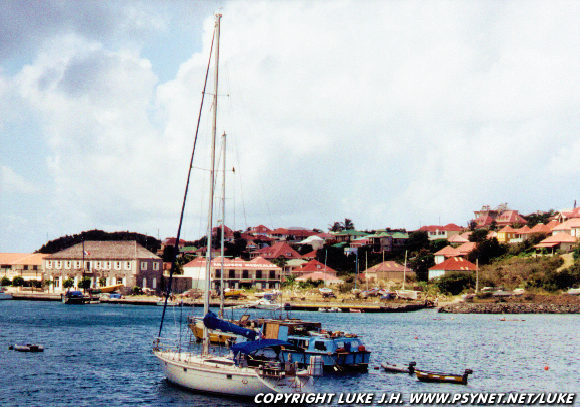
Because St. Barts was too arid for sugarcane cultivation, it never had a rich plantation-owning class, nor huge numbers of slaves. After slavery was abolished in 1847, most of the freed blacks on St. Barts left for islands where opportunities were greater. And so, say the authors of the history Bonjour St. Barth, the whites "found themselves all alone, scratching their stony fields and living off fishing."
Gustavia Harbour, Saint Barthelemy, F.W.I.
Image Copyright © LukeTravels.com™Today, the island's population is still predominantly white. "At one time, there were plenty of colored people, especially in Gustavia," Arlette Magras explains, "but when life became so difficult for everyone, many went to St. Thomas and the United States, and some never came back."
I've come to Mme. Magras's house on rue Charles de Gaulle, amid the commercial bustle of Gustavia, to talk about a time when life wasn't difficult. The island's golden age was the "Swedish century," 1785 to 1878. This middle-aged Gustavia woman has done considerable research on that period, when St. Barts was on a kind of temporary loan. Traded by the French for some warehouses in the Swedish port of Göteborg, the island was eventually handed back to them when it became a drain on the Swedish budget.
Under the Swedes, the port known as Carénage (because ships had been careened there) was renamed in honor of their king. Gustav III declared Gustavia a free port where ships of all nations could enter without paying customs, and he gave the people of St. Barts a gift that keeps on giving: He exempted them from paying taxes. That exemption was written into the treaty returning the island to France and, only slightly amended, has remained in effect until now.
A fire destroyed most of Gustavia in 1852. Little physical evidence of the Swedish presence remains: a handful of buildings on the harbor, a bell tower, the remnants of forts Karl, Oscar, and Gustav, and a few Swedish graves. "I go around cleaning those tombs in Lorient cemetery," Magras says. "A Swedish governor is buried there, and a young girl."
In Gustavia the blue-enameled signs displaying former Swedish street names along with their French replacements were installed 20 years ago by visiting, history minded Swedes. One Swedish house that remains in daily use by the people of St. Barts is the former residence of the Swedish governors, now la mairie, the town hall. There I met with the mayor, Bruno Magras, and his brother, Michel, at his side. (So many prominent islanders are named Magras - pronounced "Magraw" that they've become known, collectively and apparently with considerable affection, as "the Magrasfia.")
Bruno Magras, a licensed pilot and former airport director, looks a bit like a mid-career Charles Bronson. He entered the mayoral contest at the last minute. "Somebody's got to do it" had been his campaign slogan - or so I was told.) Michel is a quiet spoken biology teacher in the island's secondary school and serves as "adjoint au maire," Bobby Kennedy to Bruno's Jack. Michel Magras is the overseer of several thorny thickets, such as environment and sports.
The mayor and municipal council run the island's day-to-day affairs, but control ultimately resides in France. St. Barts residents sometimes express dissatisfaction with their island's status as a "dependency" of Guadeloupe, another French island 142 miles away, whose history and culture are different. Decisions made in little St. Barts must always be approved by the bigger island. There's friction over matters such as France's refusal to build a modern hospital on St. Barts, when there is already one on Guadeloupe. "The government in France doesn't realize that Guadeloupe is far, and sometimes people die in the plane," Michel Magras says. Residents of St. Barts are now raising money to build their own facility.





